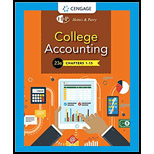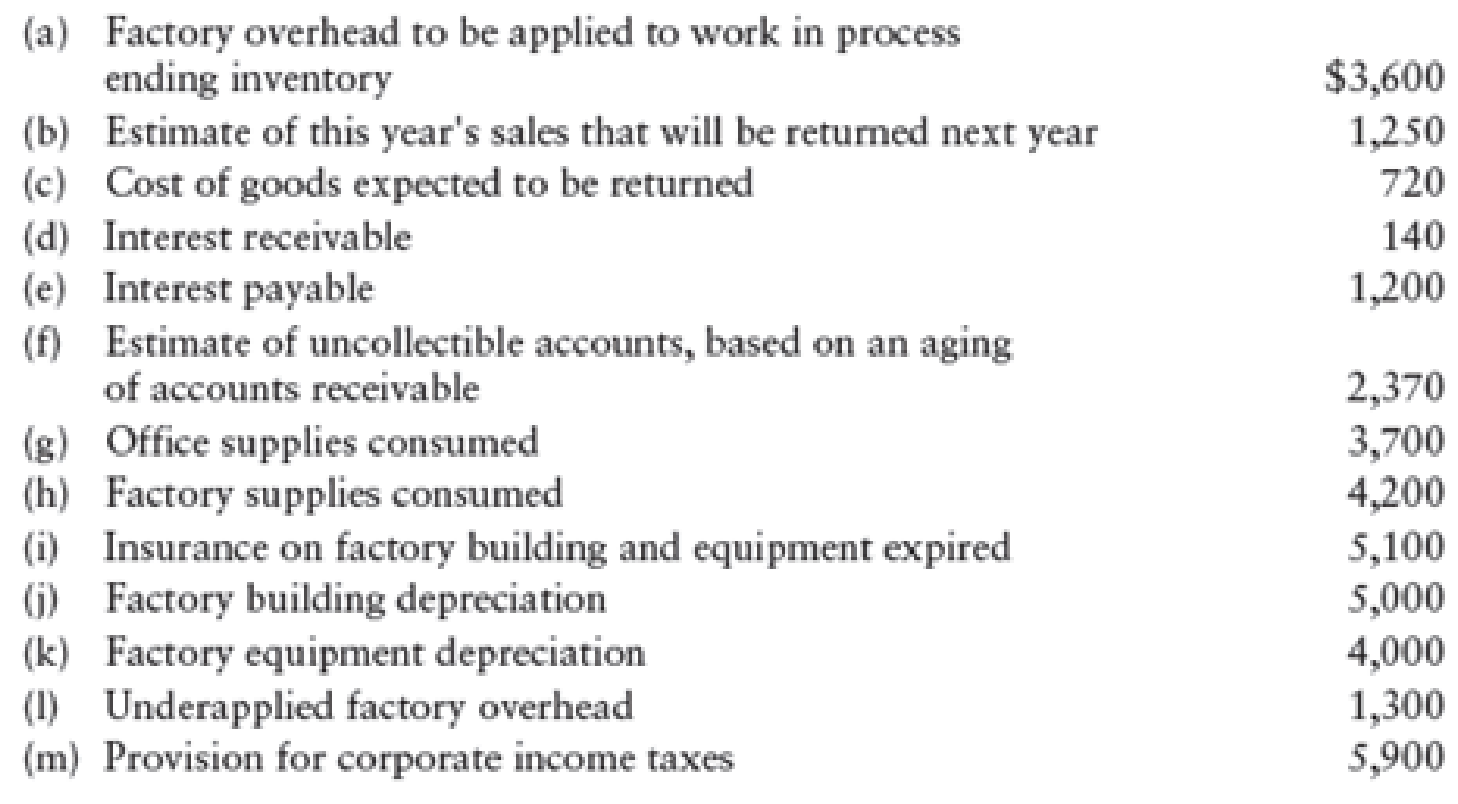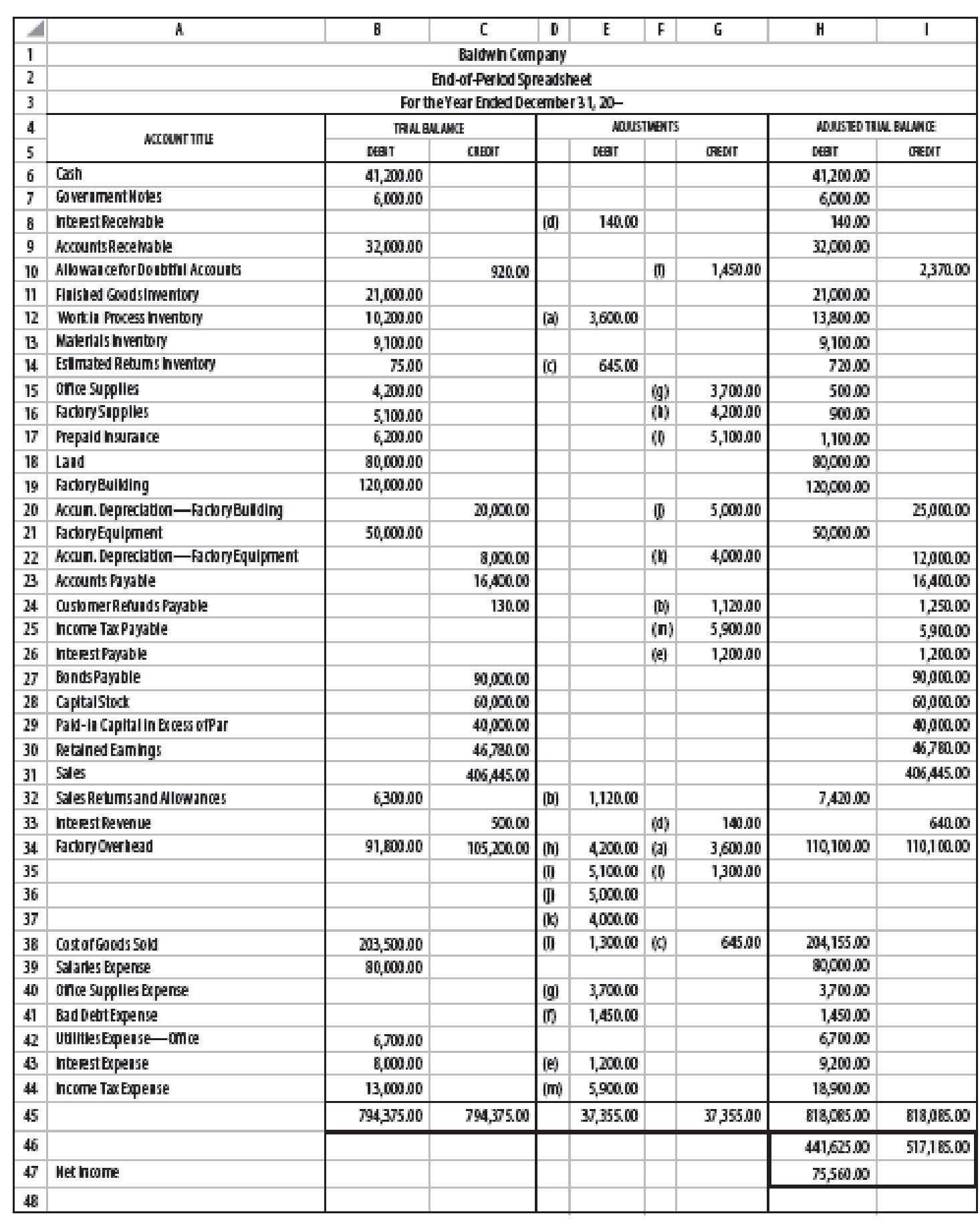
Concept explainers
ADJUSTING. CLOSING. AND REVERSING ENTRIES A 6-column spreadsheet for Baldwin Company is shown on the next page.
Data for adjusting the accounts are as follows:

REQUIRED
1. Prepare the December 31
2. Prepare the December 31 closing journal entries for Baldwin Company.
3. Prepare the reversing journal entries as of January 1,20-2, for Baldwin Company.
PROBLEM 27-8A

1.
Prepare adjusting entries of Company B for the year ended December 31.
Explanation of Solution
Adjusting entries: Adjusting entries are those entries which are recorded at the end of the year, to update the income statement accounts (revenue and expenses) and balance sheet accounts (assets, liabilities, and stockholders’ equity) to maintain the records according to accrual basis principle.
Prepare adjusting entries of Company B for the year ended December 31 as follows:
| Date | Account Title and Explanation | Post ref. | Debit ($) | Credit ($) | |
| December 31 | a. | Work in process inventory account | 3,600 | ||
| Factory overhead | 3,600 | ||||
| (To record the transfer of work in process inventory account to factory overhead) | |||||
| December 31 | b. | Sales return and allowances | 1,250 | ||
| Customer refunds payable | 1,250 | ||||
| (To record the sales return from the customer) | |||||
| December 31 | c. | Estimated returns inventory | 140 | ||
| Cost of goods sold | 140 | ||||
| (To record the expected return of cost of goods sold) | |||||
| December 31 | d. | Interest receivable | 140 | ||
| Interest revenue | 140 | ||||
| (To record the interest revenue earned at the end of the accounting year) | |||||
| December 31 | e. | Interest Expense | 1,200 | ||
| Interest Payable | 1,200 | ||||
| (To record the interest expense incurred at the end of the accounting year) | |||||
| December 31 | f. | Bad Debt Expense | 1,450 | ||
| Allowance for Doubtful Accounts | 1,450 | ||||
| (To record the bad debt expense incurred at the end of the accounting year) | |||||
| December 31 | g. | Office Supplies Expense | 3,700 | ||
| Office Supplies | 3,700 | ||||
| (To record the office supplies expense incurred at the end of the accounting year) | |||||
| December 31 | h. | Factory Overhead (supplies expense) | 1,389 | ||
| Factory Supplies | 1,389 | ||||
| (To record the supplies expense incurred at the end of the accounting year) | |||||
| December 31 | i. | Factory Overhead (insurance expense) | 5,100 | ||
| Prepaid insurance | 5,100 | ||||
| (To record the insurance expense incurred at the end of the accounting year) | |||||
| December 31 | j. | Factory overhead-(depreciation expense for factory building) | 5,000 | ||
| Accumulated Depreciation-factory building | 5,000 | ||||
| (To record the depreciation expense incurred at the end of the accounting year) | |||||
| December 31 | k. | Factory Overhead (Depreciation expense-Factory Equipment) | 4,000 | ||
| Accumulated Depreciation-Factory Equipment | 4,000 | ||||
| (To record the depreciation expense incurred at the end of the accounting year) | |||||
| December 31 | l. | Cost of Goods Sold | 1,300 | ||
| Factory Overhead | 1,300 | ||||
| (To record the factory overhead transferred to the cost of goods sold) | |||||
| December 31 | m. | Income Tax Expense | 5,900 | ||
| Income Tax Payable | 5,900 | ||||
| (To record the income tax expense incurred at the end of the account) |
Table (1)
2.
Prepare closing entries of Company B for the year ended December 31.
Explanation of Solution
Closing entries: The journal entries prepared to close the temporary accounts to Retained Earnings account are referred to as closing entries. The revenue, expense, and dividends accounts are referred to as temporary accounts because the information and figures in these accounts is held temporarily and consequently transferred to permanent account at the end of accounting year.
Prepare closing entries of Company B for the year ended December 31 as follows:
| Date | Account Title and Explanation | Post ref. | Debit ($) | Credit ($) |
| December 31 | Income Summary | 110,100 | ||
| Factory Overhead (Subsidiary ledger account) | 110,100 | |||
| (To close the subsidiary factory overheads account) | ||||
| December 31 | Factory Overhead | 110,100 | ||
| Income Summary | 110,100 | |||
| (To close the factory overhead account) | ||||
| December 31 | Sales | 406,445 | ||
| Interest revenue | 640 | |||
| Income Summary | 407,085 | |||
| (To close the sales and interest revenue account) | ||||
| December 31 | Income Summary | 331,525 | ||
| Sales returns and allowances | 7,420 | |||
| Cost of Goods Sold | 204,155 | |||
| Salaries expense | 80,000 | |||
| Office supplies expense | 3,700 | |||
| Bad debt expense | 1,450 | |||
| Utilities expense-office | 6,700 | |||
| Interest expense | 9,200 | |||
| Income tax expense | 18,900 | |||
| (To close all expenses account) | ||||
| December 31 | Income Summary | 75,560 | ||
| Retained Earnings (1) | 75,560 | |||
| (To close the income summary account) |
Table (2)
Closing entry for factory overhead:
The total debit balance of factory overhead account is transferred to the income summary account in order to bring the debit balance of factory overhead account to zero, and in the closing entry the income summary account is debited with $110,100, and the factory overhead account is credited (subsidiary ledger account) with $110,100.
The total credit balance of factory overhead account is transferred to the income summary account in order to bring the credit balance of factory overhead account to zero, and in the closing entry the factory overhead account is debited with $110,100, and the income summary account is credited with $110,100.
Closing entry for revenue account:
In this closing entry, the sales and interest revenue account is closed by transferring the amount of sales and interest revenue to the income summary account in order to bring the all revenue accounts balance to zero. Hence, debit the all revenue account for $407,085, and credit the income summary account for $407,085.
Closing entry for expenses account:
In this closing entry, all expenses are closed by transferring the amount of all expenses to the income summary account in order to bring all the expense accounts balance to zero. Hence, debit the income summary account for $331,525, and credit all the expenses account for $331,525.
Closing entry for income summary account:
In this closing entry, the income summary account is closed by transferring the amount of net income to the retained earnings account in order to bring the income summary balance to zero. Hence, debit the income summary account for $75,560, and credit the retained earnings for $75,560.
Working note (1):
Calculate the value of retained earnings.
3.
Prepare the reversing entries of Company B as of January 1, 20-2.
Explanation of Solution
Reversing entries: Reversing entries are made at the beginning of the accounting period when the accountant needs to cancel any entry made in the previous accounting period. It is done in order to eliminate any errors that might have occurred in the calculation of the revenue or expenses and henceforth increase the efficiency of the financial statements for an improved decision making.
Prepare the reversing entries of Company B as of January 1, 20-2 as follows:
Reversing entry for interest revenue:
| Date | Account Title and Explanation | Post ref. |
Debit ($) |
Credit ($) |
| January 1 | Interest revenue | 140 | ||
| Interest receivable | 140 | |||
| (To record the reversing entry for interest revenue) |
Table (3)
- ■ Interest revenue is component of shareholders’ equity, and it decreases the value of shareholders equity. Hence, debit the interest revenue with $140.
- ■ Interest receivable is an asset account, and it decreases the value of asset. Hence, credit the interest receivable account with $140.
Reversing entry for interest expense:
| Date | Account Title and Explanation | Post ref. |
Debit ($) |
Credit ($) |
| January 1 | Interest payable | 1,200 | ||
| Interest expense | 1,200 | |||
| (To record the reversing entry for interest expense) |
Table (4)
- ■ Interest payable is a liability account and it decreases in the value of liabilities. Hence, debit the interest payable with $1,200.
- ■ Interest expense is component of shareholders’ equity, and it increases the value of shareholders equity. Hence, credit the interest expense with $1,200.
Reversing entry for factory overheads:
| Date | Account Title and Explanation | Post ref. |
Debit ($) |
Credit ($) |
| January 1 | Factory Overhead | 3,600 | ||
| Work in Process Inventory | 3,600 | |||
| (To record the reversing entry for factory overhead) |
Table (5)
- ■ Factory overhead (expense) is a component of owner’s equity, and there is an increase in the value of expense. Hence, debit the factory overhead account with $3,600.
- ■ Work in process inventory is an asset account, and it decreases the value of asset. Hence, credit the work in process inventory account with $3,600.
Want to see more full solutions like this?
Chapter 27 Solutions
College Accounting, Chapter 1-15 (Looseleaf)
- Please provide the correct answer to this general accounting problem using accurate calculations.arrow_forwardCan you demonstrate the proper approach for solving this financial accounting question with valid techniques?arrow_forwardPlease provide the correct answer to this general accounting problem using accurate calculations.arrow_forward
- I need help finding the correct solution to this financial accounting problem with valid methods.arrow_forwardCan you solve this financial accounting question with the appropriate financial analysis techniques?arrow_forwardCan you solve this general accounting problem with appropriate steps and explanations?arrow_forward
 College Accounting, Chapters 1-27AccountingISBN:9781337794756Author:HEINTZ, James A.Publisher:Cengage Learning,
College Accounting, Chapters 1-27AccountingISBN:9781337794756Author:HEINTZ, James A.Publisher:Cengage Learning, College Accounting, Chapters 1-27 (New in Account...AccountingISBN:9781305666160Author:James A. Heintz, Robert W. ParryPublisher:Cengage LearningCentury 21 Accounting Multicolumn JournalAccountingISBN:9781337679503Author:GilbertsonPublisher:Cengage
College Accounting, Chapters 1-27 (New in Account...AccountingISBN:9781305666160Author:James A. Heintz, Robert W. ParryPublisher:Cengage LearningCentury 21 Accounting Multicolumn JournalAccountingISBN:9781337679503Author:GilbertsonPublisher:Cengage Financial Accounting: The Impact on Decision Make...AccountingISBN:9781305654174Author:Gary A. Porter, Curtis L. NortonPublisher:Cengage Learning
Financial Accounting: The Impact on Decision Make...AccountingISBN:9781305654174Author:Gary A. Porter, Curtis L. NortonPublisher:Cengage Learning College Accounting (Book Only): A Career ApproachAccountingISBN:9781337280570Author:Scott, Cathy J.Publisher:South-Western College Pub
College Accounting (Book Only): A Career ApproachAccountingISBN:9781337280570Author:Scott, Cathy J.Publisher:South-Western College Pub





